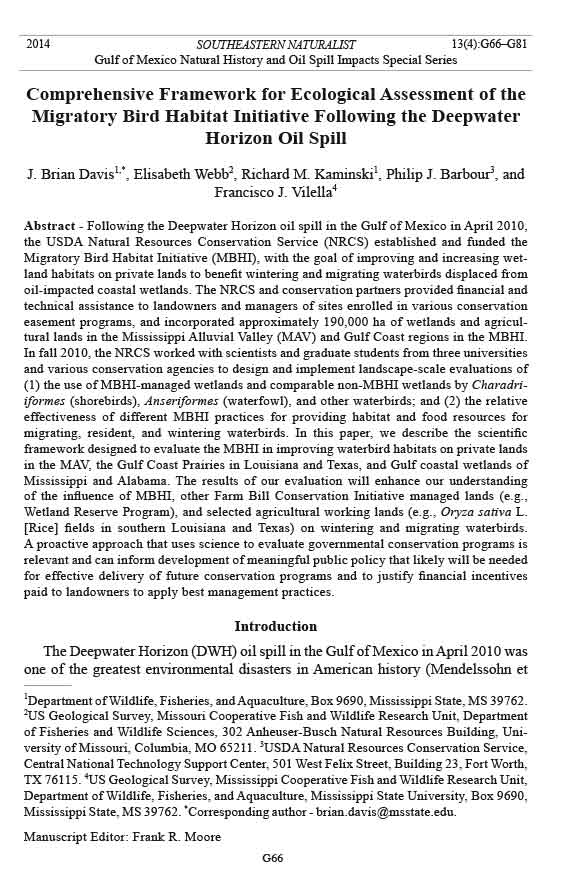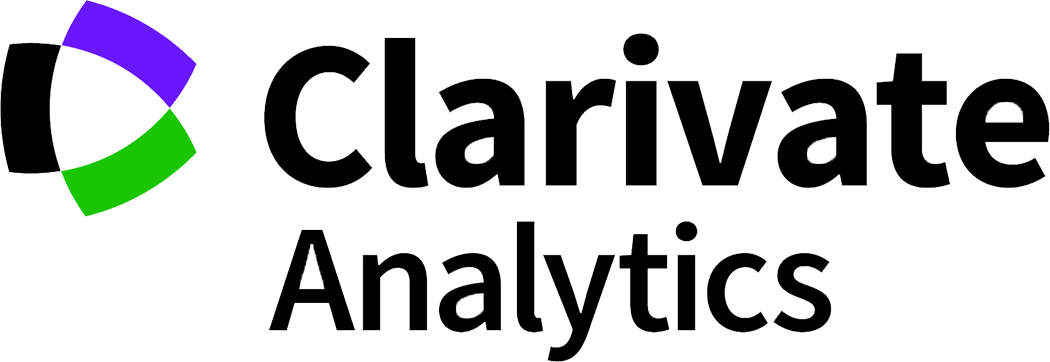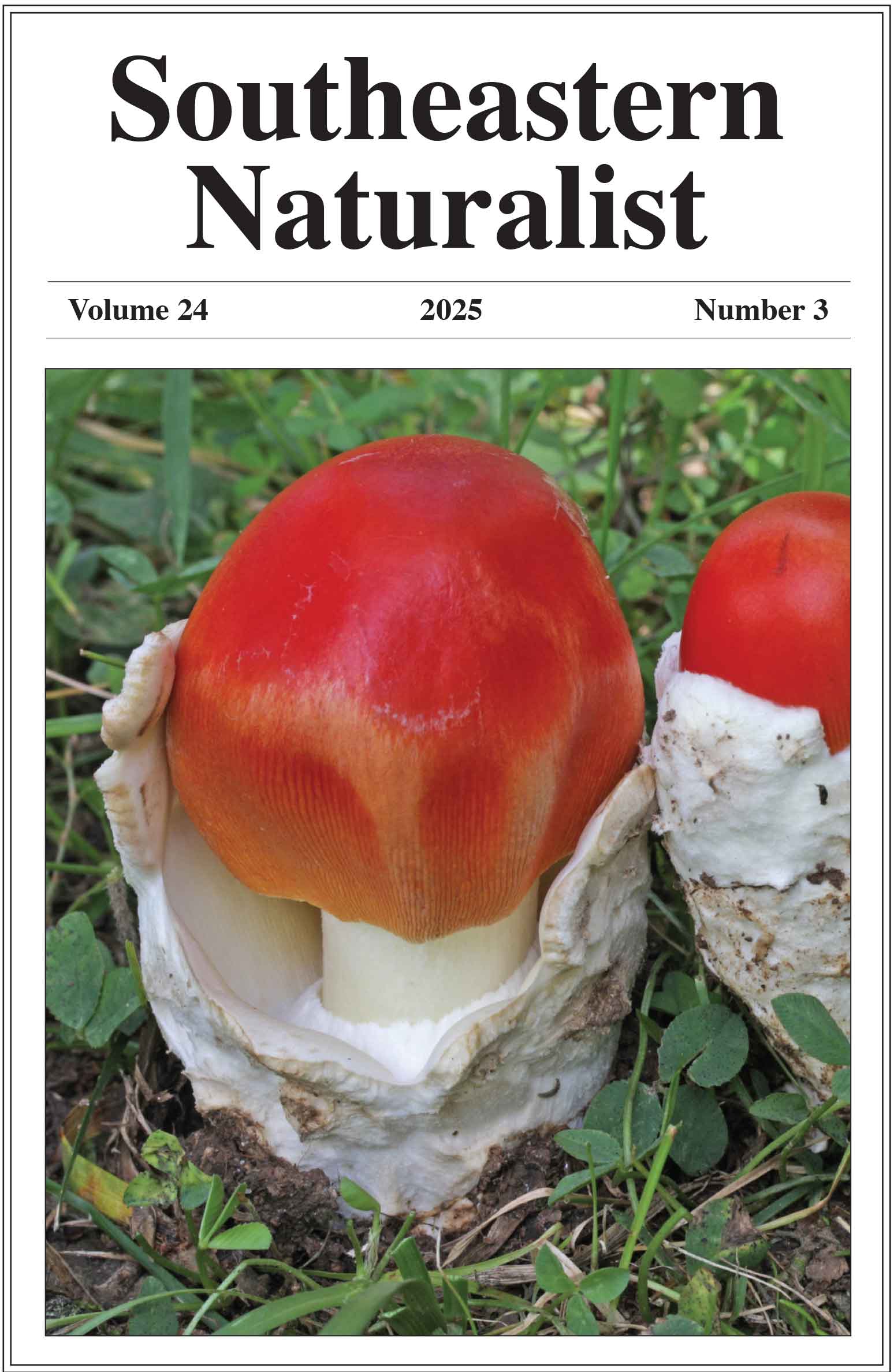Comprehensive Framework for Ecological Assessment of the
Migratory Bird Habitat Initiative Following the Deepwater
Horizon Oil Spill
J. Brian Davis, Elisabeth Webb, Richard M. Kaminski, Philip J. Barbour, and Francisco J. Vilella
Southeastern Naturalist, Volume 13, Issue 4 (2014): G66–G81
Full-text pdf (Accessible only to subscribers.To subscribe click here.)

Southeastern Naturalist
J.B. Davis, E. Webb, R.M. Kaminski, P.J. Barbour, and F.J. Vilella
2014 Vol. 13, No. 4
G66
SOUTHEASTERN NATURALIST
Gulf of Mexico Natural History and Oil Spill Impacts Special Series
2014 13(4):G66–G81
Comprehensive Framework for Ecological Assessment of the
Migratory Bird Habitat Initiative Following the Deepwater
Horizon Oil Spill
J. Brian Davis1,*, Elisabeth Webb2, Richard M. Kaminski1, Philip J. Barbour3, and
Francisco J. Vilella4
Abstract - Following the Deepwater Horizon oil spill in the Gulf of Mexico in April 2010,
the USDA Natural Resources Conservation Service (NRCS) established and funded the
Migratory Bird Habitat Initiative (MBHI), with the goal of improving and increasing wetland
habitats on private lands to benefit wintering and migrating waterbirds displaced from
oil-impacted coastal wetlands. The NRCS and conservation partners provided financial and
technical assistance to landowners and managers of sites enrolled in various conservation
easement programs, and incorporated approximately 190,000 ha of wetlands and agricultural
lands in the Mississippi Alluvial Valley (MAV) and Gulf Coast regions in the MBHI.
In fall 2010, the NRCS worked with scientists and graduate students from three universities
and various conservation agencies to design and implement landscape-scale evaluations of
(1) the use of MBHI-managed wetlands and comparable non-MBHI wetlands by Charadriiformes
(shorebirds), Anseriformes (waterfowl), and other waterbirds; and (2) the relative
effectiveness of different MBHI practices for providing habitat and food resources for
migrating, resident, and wintering waterbirds. In this paper, we describe the scientific
framework designed to evaluate the MBHI in improving waterbird habitats on private lands
in the MAV, the Gulf Coast Prairies in Louisiana and Texas, and Gulf coastal wetlands of
Mississippi and Alabama. The results of our evaluation will enhance our understanding
of the influence of MBHI, other Farm Bill Conservation Initiative managed lands (e.g.,
Wetland Reserve Program), and selected agricultural working lands (e.g., Oryza sativa L.
[Rice] fields in southern Louisiana and Texas) on wintering and migrating waterbirds.
A proactive approach that uses science to evaluate governmental conservation programs is
relevant and can inform development of meaningful public policy that likely will be needed
for effective delivery of future conservation programs and to justify financial incentives
paid to landowners to apply best management practices.
Introduction
The Deepwater Horizon (DWH) oil spill in the Gulf of Mexico in April 2010 was
one of the greatest environmental disasters in American history (Mendelssohn et
1Department of Wildlife, Fisheries, and Aquaculture, Box 9690, Mississippi State, MS 39762.
2US Geological Survey, Missouri Cooperative Fish and Wildlife Research Unit, Department
of Fisheries and Wildlife Sciences, 302 Anheuser-Busch Natural Resources Building, University
of Missouri, Columbia, MO 65211. 3USDA Natural Resources Conservation Service,
Central National Technology Support Center, 501 West Felix Street, Building 23, Fort Worth,
TX 76115. 4US Geological Survey, Mississippi Cooperative Fish and Wildlife Research Unit,
Department of Wildlife, Fisheries, and Aquaculture, Mississippi State University, Box 9690,
Mississippi State, MS 39762. *Corresponding author - brian.davis@msstate.edu.
Manuscript Editor: Frank R. Moore
Southeastern Naturalist
G67
J.B. Davis, E. Webb, R.M. Kaminski, P.J. Barbour, and F.J. Vilella
2014 Vol. 13, No. 4
al. 2012, Pitre et al. 2011). This type of disaster provides opportunities for research
to assess potential effects of environmental impacts and implemented mitigation
activities on plants, animals, and other natural resources (Garton et al. 2012, Vilella
and Fogarty 2005, White et al. 2005). Although bias can be introduced into postdisaster
experiments because treatments and replicates often cannot be allocated
randomly, adequate replication for robustness may be lacking, and true or pseudocontrols
may not be possible, scientific evaluations are still possible to elucidate
effects on wildlife and other natural resources and guide subsequent habitat restoration
and other conservation efforts (Diamond and Robinson 2010, Garton et al.
2012, Golightly et al. 2011).
It is important for environmental impact assessments to evaluate effects on
resident and migratory birds because they occupy diverse habitats and thus are
likely to use areas affected by oil spills or other environmental accidents (Irons
et al. 2000, Iverson and Esler 2010, Wiens et al. 2004). Unlike seabirds that have
limited alternative offshore habitats following an offshore oil spill, landbirds may
detect and subsequently avoid compromised areas and resources (Day et al. 1997).
Most shorebirds, waterfowl, and other waterbirds are considered resource-sampling
specialists because they frequently locate and readily use newly available habitats
and resources, such as recently inundated wetlands (Hagy and Kaminski 2012,
Heitmeyer 2006). If migrating birds can exploit habitats and resources disjunct
from environmentally impacted areas, then increasing acreage of these areas within
migratory-bird ranges may help mitigate the loss of environments compromised by
oil spills or other disasters (Corn and Copeland 2010).
It may be difficult for biologists, managers, and administrators to determine the
scale and effort at which to mitigate beyond core areas of natural disasters such as oil
spills to protect wildlife species, making the task of allocating limited funding and
logistical resources particularly challenging (Estes 1998, Jessup 1998). In summer
2010, in response to the DWH, the United States Department of Agriculture (USDA)
Natural Resources Conservation Service (NRCS) quickly established and funded
the Migratory Bird Habitat Initiative (MBHI) to provide private landowners in
eight US Gulf and Atlantic coastal states with $40 million in cost-share assistance,
through temporary conservation contracts, to create and manage wetland habitats
on ~190,000 ha for use by migratory birds (NRCS 2012). Gulf coastal wetlands are
important stopover and wintering habitats for diverse North American birds (Baldassarre
and Bolen 2006; Chabreck et al. 1971, 1989; Elphick et al. 2010; Helmers
1992; Marty 2013). Hence, NRCS staff reasoned that creating and managing inland
wetlands (e.g., flooded ricefields, Wetland Reserve Program [WRP] wetlands) could
provide alternate habitat and resources for migrant and resident birds away from
oil-impacted areas along the coast. Additionally, the NRCS assumed that providing
these habitats on private lands would increase overall habitat carrying-capacity for
these birds inland from the coast, although the NRCS recognized that no evaluation
could precisely determine the extent to which birds originally destined for coastal
wetlands used MBHI lands instead of coastal habitats. The many acronyms used in
this paper are listed and explained in Table 1 for quick reference.
Southeastern Naturalist
J.B. Davis, E. Webb, R.M. Kaminski, P.J. Barbour, and F.J. Vilella
2014 Vol. 13, No. 4
G68
Thus, several studies were initiated to assess environmental impacts associated
with the DWH (Lubchenco et al. 2012, McNutt et al. 2012), including a cooperative
agreement between NRCS and Mississippi State University (MSU) to conduct
a three-year evaluation (2010–2013) of the MBHI focusing on waterbird use and
food-resource availability in Oryza sativa L. (Rice) fields and WRP wetlands managed
with MBHI funding in the Lower Mississippi Alluvial Valley (MAV) and Gulf
Coast (GC) regions. Implementation of MBHI represented an innovative effort by a
US federal agency to provide incentives to private landowners to apply prescribed
management practices in response to a major environmental disaster. NRCS’s
decision to evaluate MBHI demonstrated the agency’s interest in documenting
waterbird benefits derived from the MBHI. The MBHI assessment that we describe
here complements the assessments underway through the USDA’s Conservation Effects
Assessment Project, which involves multiple federal, state, and local agencies
that cooperate to quantify environmental effects of management practices applied
at large spatial scales on working agricultural and natural landscapes (Brinson and
Eckles 2011, USDA-CEAP 2013).
We evaluated MBHI management practices generally associated with Farm
Bill conservation programs at multiple scales in the MAV and GC regions (e.g.,
WRP; Fleming et al. 2012, Olmstead et al. 2013). Our research team included
biologists from Ducks Unlimited, Inc., Jackson, MS; Mississippi Department of
Wildlife, Fisheries, and Parks, Jackson, MS; Mississippi State University, Mississippi
State, MS; the North American Waterfowl Management Plan (NAWMP)
Gulf Coast and Lower Mississippi Valley Joint Ventures (JVs), Vicksburg, MS;
the University of Missouri-Columbia, Columbia, MO; and US Geological Survey’s
Mississippi and Missouri Cooperative Fish and Wildlife Research Units,
Mississippi State, MS, and Columbia, MO, respectively. Scientists and graduate
students from the two universities are continuing to work on MBHI assessment
in six states. Each study was an independent or integrated evaluation of
Table 1. Acronyms and affiliations of agencies or programs used in this p aper.
Acronym Affiliation
CA Conservation Areas
CEAP Conservation Effects Assessment Project
DWP Deepwater Horizon
GC Gulf Coast
JV Joint Ventures
LCC Landscape Conservation Cooperatives
MAV Mississippi Alluvial Valley
MBHI Migratory Bird Habitat initiative
MSU Mississippi State University
NABCI North American Bird Conservation Initiative
NAWMP North American Waterfowl Management Plan
NRCS Natural Resources Conservation Service
NWR National Wildlife Refuge
USDA United States Department of Agriculture
WRP Wetland Reserve Program
Southeastern Naturalist
G69
J.B. Davis, E. Webb, R.M. Kaminski, P.J. Barbour, and F.J. Vilella
2014 Vol. 13, No. 4
particular aspects of MBHI; when and where integrated, projects were designed
to enable spatiotemporal comparisons between MBHI-managed and paired
non-managed wetlands and assess relative effects of different MBHI practices
in providing habitat and food resources for migratory and resident waterbirds.
Thus, our evaluation of MBHI was a designed natural experiment to assess management
practices applied by incentivized landowners after the DWH oil spill.
Although our studies will continue through 2015, preliminary results reported
herein suggest that lands under MBHI management exhibited greater waterbird
use and contained more potential food resources than non-MBHI wetlands
during our research period. Moreover, current MBHI outcomes contribute to
missions of three landscape-conservation initiatives: MBHI, Gulf of Mexico
Initiative, and Mississippi River Basin Healthy Watersheds Initiative (NRCS
2012). For this paper, our primary goal was to communicate the objectives and
conceptual research framework for the ecological assessment of the MBHI to
ecologists, conservationists, and the public. We present general methodological
approaches and preliminary descriptive results from several completed theses
by graduate students (e.g., Feaga 2014, Lancaster 2013, Marty 2013, Tapp 2013,
Weegman 2013). Additional analyses will be conducted on a more comprehensive
data set. We also discuss the implications of our evaluation for integration
with existing continental landscape-conservation initiatives, namely the
NAWMP, JVs, and the Landscape Conservation Cooperatives (LCC; Jacobson
and Robertson 2012).
Field-site Description
We conducted evaluations in Alabama, Arkansas, Louisiana, Mississippi, Missouri,
and Texas beginning in fall 2010, after the DWH oil spill (Fig. 1). Our
studies occurred in parts of two LCC regions: the Gulf Coastal Plains and Ozarks
and the Gulf Coast Prairie (US Department of Interior LCC 2013). Our study sites
in NAWMP JV areas were located within the Lower Mississippi Valley, the Gulf
Coast, and the East Gulf Coastal Plain. We describe each project below (Table 2;
NAWMP 2012).
Study Objectives and Design
Waterbird and seed abundance and diversity in MBHI and non-managed
wetlands
We designed and implemented three studies to evaluate waterbird and food
abundance and diversity on MBHI sites and comparable non-managed wetlands in
Arkansas, Louisiana, Mississippi, Missouri, and Texas. Estimates of potential seed
and aquatic invertebrate abundance will enable NRCS and other conservation partners
to estimate carrying capacity of managed and unmanaged wetlands for resident
and migratory waterfowl and other birds in the MAV and GC JV regions. Additionally,
our protocols can be adapted for use by LCCs, NAWMP, and partners in other
regions to acquire comparable data sets to guide habitat-conservation planning and
implementation in North America.
Southeastern Naturalist
J.B. Davis, E. Webb, R.M. Kaminski, P.J. Barbour, and F.J. Vilella
2014 Vol. 13, No. 4
G70
Table 2. Study-specific information for Migratory Bird Habitat Initiative evaluations on private lands,
beginning in 2010.
State(s) Land types Research focus
Mississippi Wetland Reserve Program (WRP) Water quality
wetlands and adjacent croplands
Mississippi Catfish ponds (idle, active commercial) Bird and bird food abundance
Alabama, Louisiana, Idle catfish ponds, croplands, inland and Bird and bird food abundance.
Missouri, Mississippi coastal wetlands Isotopic analysis of bird tissues.
Mississippi Croplands, wetlands Waterfowl habitat use and
female mallard survival
Louisiana, Texas Active and idled rice lands Estimation of waste rice/weed
seed and bird abundance
Arkansas, Missouri WRP wetlands Bird and bird food abundance
Louisiana, Mississippi WRP wetlands Bird and bird food abundance
Figure 1. Primary study areas for 8 separate or related evaluations of water quality and food
abundance in wetlands and ricelands, and waterbird use of these habitats beginning fall
2010, following the Deepwater Horizon Oil Spill in 2010.
Southeastern Naturalist
G71
J.B. Davis, E. Webb, R.M. Kaminski, P.J. Barbour, and F.J. Vilella
2014 Vol. 13, No. 4
In Louisiana and Mississippi, our objectives were to estimate seed and waterbird
densities and species richness on WRP lands in the MAV portions of these
states, and compare these metrics between MBHI and non-managed sites within
replicate landowner properties (e.g., Fleming 2010, Fleming et al. 2012). We estimated
relative abundances of detected waterbirds using conventional flush surveys
from late summer 2011 through April 2012 (Fleming 2010, Weegman 2013). We
also collected soil cores from wetlands in October 2011 and March 2012 to estimate
moist-soil seed abundance for migrating and wintering waterbirds, in part so
that LCC partners could then use these data to calculate duck and other waterbird
energy-days (Kross et al. 2008, Reinecke et al. 1989).
Similarly in Arkansas and Missouri, we quantified habitat use by fall-migrating
shorebirds, wintering ducks, and other waterbirds on lands enrolled in MBHI,
WRP lands not enrolled in MBHI, and managed publicly owned wetlands. We
also estimated seed and aquatic invertebrate abundance and diversity at these
wetlands (Tapp 2013). Additionally, in order to guide location and development
of wetlands and associated habitat complexes that promote waterfowl and other
waterbird use (e.g., Pearse et al. 2012), Tapp (2013) examined adjacent land-use
and habitat composition around study wetlands to discern if these factors were
correlated with avian use of wetlands.
In Louisiana and Texas, we sampled abundance of waste Rice (i.e., grain
remaining on harvested fields [Stafford et al. 2006]) and natural seeds in differently
managed ricelands to estimate carrying capacity of ricelands in production
and temporarily idled ricelands in the GC JV (Marty 2013). We also conducted
surveys to estimate waterbird abundance and species richness, and characterize
avian-community structure on MBHI and other ricelands in the GC JV region during
autumn through spring. Although studies similar to ours have been conducted
in the MAV (Kross et al. 2008; Manley et al. 2004; Stafford et al. 2006, 2010),
an analogous study has not been conducted in the GC JV region, where Rice
agri-systems and production strategies differ markedly from practices in the MAV
(Marty 2013).
Waterbird use and food abundance in aquaculture ponds
In addition to studying croplands and WRP easements enrolled in MBHI, NRCS
partnered with private landowners to provide waterbird and shorebird habitat in
idled Ictalurus punctatus Rafinesque (Channel Catfish) production ponds in Mississippi.
We conducted ground surveys to estimate waterbird abundance and species
richness, and quantified seed and aquatic invertebrate abundance in idled and active
catfish-production ponds during winters 2011–2013. Idled ponds were flooded to
provide mudflats and shallow water (less than 30 cm) for shorebirds and other waterbirds,
as prescribed under the MBHI program.
Shorebird-habitat use and stable isotopes
In another ongoing study, we are evaluating shorebird and other waterbird use
of idle catfish ponds and wetlands in National Wildlife Refuges (NWRs) and state
conservation areas (CAs) in the MAV and GC regions of Alabama, Louisiana,
Southeastern Naturalist
J.B. Davis, E. Webb, R.M. Kaminski, P.J. Barbour, and F.J. Vilella
2014 Vol. 13, No. 4
G72
Mississippi, and Missouri. Our objectives are to quantify species composition and
relative abundance of migrating shorebirds using MBHI-managed idled catfish
ponds in the MAV and GC regions during July–October, estimate invertebrate food
resources for these birds, and use stable-isotope analyses (e.g., carbon, nitrogen,
hydrogen) to infer shorebird migratory connectivity among locations in the MAV
and GC regions. We will also assess presence of petroleum-derived hydrocarbon
material in shorebird tissues, soil, and aquatic invertebrates from GC habitats. We
are following survey protocols of the Integrated Waterbird Management and Monitoring
Program Manual developed by the US Geological Survey and the US Fish
and Wildlife Service (USFWS 2010). We are processing core samples for estimation
of invertebrate biomass in MBHI-managed wetlands and will then conduct
stable isotope analyses.
Use of habitats by radiomarked mallards
In a departure from ground-based visual surveys of wetland birds, we used
radiomarked female Anas platyrhynchos L. (Mallard) to assess use of MBHI and
other wetlands. We have completed two of four winters of our study to quantify
survival, habitat use, and movements of radiomarked Mallards in western Mississippi
in relation to MBHI and other wetlands in the MAV (Lancaster 2013). We
treated each unique habitat used by ducks as a state in a multi-state model (White
et al. 2006). Similarly, we categorized in-program (e.g., MBHI, WRP) and nonprogram
lands as states in the model. These distinctions will allow us to identify
specific MBHI, WRP, and other habitats that promote Mallard winter-habitat use
and survival (Lancaster 2013).
Wetland water-quality
A doctoral research project used fixed monitoring stations to quantify nutrients
and sediment in runoff in four seasonally flooded, moist-soil wetlands and four adjacent
agricultural fields in the Mississippi MAV from July 2010 to May 2012 (A.
Alford, Forest and Wildlife Research Center, Mississippi State University, Mississippi
State, MS, pers. comm.). This project was ancillary to the MBHI evaluation
project, but the results are important to NRCS and other environmental conservation
programs. For example, moist-soil wetlands comprise approximately 71,608
ha of WRP lands in Mississippi and can help reduce nutrient and sediment inputs
to downstream wetlands and ultimately, lessen hypoxia in the Gulf of Mexico
(USDA-NRCS 2013a, b). Understanding wetland nutrient–sediment dynamics and
retention within an agricultural landscape can inform and promote sustainable
land-conservation practices in the future (Manley et al. 2009).
Preliminary Results and Implications
Waterbird and seed abundance and diversity in MBHI and non-managed
wetlands
Wetlands enrolled in MBHI contained over 100% more total seed biomass than
non-managed wetlands (Weegman 2013). We also detected ~3 times more Anatini
Southeastern Naturalist
G73
J.B. Davis, E. Webb, R.M. Kaminski, P.J. Barbour, and F.J. Vilella
2014 Vol. 13, No. 4
(dabbling ducks) and all ducks combined on MBHI-managed than control wetlands.
Additionally, waterbirds other than waterfowl and shorebirds were over two times
more abundant on MBHI-managed than non-managed wetlands.
In Arkansas and Missouri, the number of dabbling ducks was more than two
times greater in MBHI wetlands than non-managed private wetlands (Tapp 2013).
Natural seed abundance during winter was 21% higher on MBHI wetlands than
non-managed wetlands. Although aquatic invertebrate biomass and number of invertebrate
families (i.e., an index of diversity) among managed and non-managed
wetlands were statistically insignificant, secondary production of invertebrates
during autumn (kg/ha) was 3 times greater on MBHI wetlands than non-managed
wetlands (Tapp 2013). Moreover, invertebrate biomass during winter was approximately
40% greater on MBHI and non-managed wetlands than publicly owned
managed wetlands. Collectively, these results suggest that management of MBHI
wetlands increased the potential carrying capacity of these wetlands for migrating,
wintering, and resident waterbirds in the MAV.
Some preliminary results from our ongoing Louisiana and Texas waterbird study
were presented in Marty (2013). Specifically, flooded ricelands on MBHI lands
supported high densities of migrating and wintering waterbirds (~37 birds/ha) compared
to non-flooded Rice fields (~5 birds/ha), suggesting that MBHI incentives
for Rice producers to flood fields after harvest benefit these avain species (Marty
2013). As expected, non-flooded ricelands received little use by waterbirds, and
we observed different bird communities in active and idle Rice fields. When both
habitats were flooded, ducks and geese dominated fields in production, but idled
fields were used by a diversity of shorebirds, wading birds, and other waterbirds.
Landscape-scale complexes of created wetlands (e.g., flooded Rice fields and other
croplands), idled fields with natural vegetation, and natural wetlands support diverse
communities of waterfowl and wetland-dependent birds (Pearse et al. 2012).
MBHI-managed ratoon-Rice fields (i.e., fields that produce two Rice crops/year)
contained the greatest density of waste grain as potential food for wintering waterfowl.
For example, waste Rice biomass in flooded ratoon Rice fields in Louisiana
was ~3 times greater than the amount estimated in MAV Rice fields (Marty 2013,
Stafford et al. 2006). When flooded, Rice fields in production and fields temporarily
idled for soil and water conservation contained abundant natural seedbanks,
which increased the foraging carrying capacity and available nutrient diversity of
these habitats for waterbirds (Marty 2013). The autumn average of over 350 kg/ha
in Gulf Coast Rice fields (active and idled combined) was 63% of the average seedmass
found in managed moist-soil wetlands on public lands in the MAV (Kross et
al. 2008). Although natural seed abundance was lower in these Rice fields, perhaps
because natural seed recruitment into soils was reduced due to use of glyphosateresistant
Rice varieties in production years, these natural seedbanks increased
the foraging capacity and forage-nutrient diversity in ricefields for migrating and
wintering waterfowl and other birds. Our study will continue through 2015, and additional
data will increase the reliability of our Rice and natural seed estimates (i.e.,
goal = CV ≤ 15%; Kross et al. 2008, Marty 2013, Stafford et al. 2006) for use by
Southeastern Naturalist
J.B. Davis, E. Webb, R.M. Kaminski, P.J. Barbour, and F.J. Vilella
2014 Vol. 13, No. 4
G74
NRCS and other GC JV partners. Our preliminary results underscore the importance
of ricelands in the Gulf coastal prairies for migratory waterfowl and other waterbirds,
assuming Rice fields are flooded through MBHI or other management efforts
to make these habitats accessible for waterfowl and other waterbirds (Marty 2013).
Waterbird use and food abundance in aquaculture ponds
Feaga (2014) reported the following preliminary results from surveys designed
to estimate waterbird and food abundance in idled and production Channel Catfish
ponds. Under MBHI management, migrating and wintering waterfowl and
other waterbirds on aquaculture impoundments in production exhibited similar
densities to those on idled aquaculture impoundments (~22 and ~20 birds/ha, respectively);
this finding suggests that both types of wetlands provide important
migration and overwintering habitat for waterbirds (Feaga 2014). Additionally,
our results suggest that different bird communities occur on idled aquaculture
impoundments and those in production. When flooded, several species of diving
and dabbling ducks and Fulica americana Gmelin (American Coots) were dominant
in active aquaculture impoundments (Christopher et al. 1988, Dubovsky and
Kaminski 1992), whereas idled impoundments were used by over 40 species of
ducks, shorebirds, wading birds, and other waterbirds due to the presence of variable
water depths (i.e., mudflats to shallowly flooded areas) and diverse plant
communities (Feaga 2014).
Feaga (2014) sampled moist-soil seeds in idled Channel Catfish ponds at 2
MBHI and 2 NWR sites in the Mississippi MAV and recorded 30 and 42 plant
genera in MBHI and NWR sites, respectively. Mean density of seeds known to be
waterfowl foods (Hagy and Kaminski 2012) was ~1.4 times greater on NWR than
MBHI sites, likely because NWR sites were managed more actively for moist-soil
plants and agronomic crops than MBHI sites (Feaga 2014, Kross et al. 2008).
Shorebird habitat use and stable isotopes
Preliminary results from shorebird surveys indicated that significantly
more shorebirds were observed on shallowly flooded MBHI wetlands in idled
Channel Catfish ponds from August through September in Mississippi than
on Channel Catfish ponds in production, state and federal CAs, or Gulf coastal
wetlands. Thus, MBHI-managed former Channel Catfish ponds provide important
habitat for migrating shorebirds and other waterbirds during summer–fall,
especially in drought years when other wetland habitat is limited.
Use of habitats by radiomarked mallards
Mallards wintering in the MAV of Mississippi exhibited the greatest survival
rates when their home ranges included wetland complexes composed of forested,
scrub-shrub, and moist-soil wetlands, flooded croplands, and permanent water bodies,
instead of monotypic habitat landscapes (Lancaster 2013). Future conservation
efforts on public and private lands should include creation of these multi-habitat
wetland complexes to provide suitable habitat for Mallards, other ducks, and
waterbirds, thus promoting avian winter survival and fitness (sensu Fretwell 1972).
Southeastern Naturalist
G75
J.B. Davis, E. Webb, R.M. Kaminski, P.J. Barbour, and F.J. Vilella
2014 Vol. 13, No. 4
Additionally, >70% of 110 radiomarked female Mallards spent nearly 20% of monitored
days on MBHI or other Farm Bill conservation-program lands (e.g., WRP).
Daily survival of female Mallards was ≥98% on Farm Bill conservation lands
during winter 2010–2012, and there was no female mortality on MBHI-enrolled
wetlands during the same time period. Thus, MBHI and other Farm Bill wetlands
apparently provided important habitats and resources for wintering Mallards and
other ducks in Mississippi and may have contributed to the birds’ winter survival
and potential return to breeding grounds.
Wetland water quality
Selected preliminary water-quality results from this study follow recommendations
of A. Alford (unpubl. data). Total phosphorus, particulate phosphorus, nitrate
nitrogen, and total suspended-solid concentrations were 42–89% lower in moist-soil
wetland runoff than run-off from row-crop agricultural lands. Loads (kg/ha) of total
suspended solids exported from moist-soil wetlands were 50% lower than loads
exported from agricultural fields, and the majority of the sediments exported from
wetlands was concentrated within less than 15% of the total discharge events. Estimates
of total phosphorus loads from moist-soil wetlands were 2.39 kg/ha/year; a value
greater than the assumed 1.0 kg/ha/year phosphorus-loading rate used in Mississippi
(Alford 2014) to estimate the contribution from wetlands to nutrient pollution in the
Mississippi River basin. The increase in phosphorus loads from moist-soil wetlands
may be caused by the breakdown and decomposition of emergent vegetation in these
wetlands during fall–spring inundation and run-off events. Because ours is the first
empirical estimate of phosphorous-loading from natural moist-soil wetlands in Mississippi,
replication is needed for validation.
Discussion
Decades prior to the MBHI, the North American Waterfowl Management Plan
(NAWMP) was enacted and associated JVs initiated continental efforts to reverse
declining waterfowl populations by increasing habitat across North America
(NAWMP 1986, 2012). The NAWMP (1986, 2012) has remained one of the most
comprehensive wildlife-habitat initiatives and an example of effective landscapelevel
conservation efforts at a continental scale implemented worldwide (King
et al. 2006). Subsequent efforts, such as the North American Bird Conservation
Initiative (NABCI), sought to integrate all bird-management plans (e.g., waterfowl,
shorebird, waterbird, landbird plans) to sustain game and non-game species
and populations, and LCCs were implemented recently to conserve and manage
natural resources at ecosystem-level scales in North America (King et al. 2006).
The LCCs are applied conservation-science partnerships of states, tribes, federal
agencies, non-governmental organizations, universities and other groups working
collaboratively to (1) provide science and technical expertise needed to support
conservation planning at the landscape scale, and (2) promote collaboration among
the members to define shared conservation goals (http://www.fws.gov/landscapeconservation/
lcc.html). The NRCS is one of six US federal partners of LCCs,
Southeastern Naturalist
J.B. Davis, E. Webb, R.M. Kaminski, P.J. Barbour, and F.J. Vilella
2014 Vol. 13, No. 4
G76
and the MBHI represents the first effort by a federal agency to create temporary
agreements with landowners to provide alternate managed habitats for wetlanddependent
wildlife in response to an environmental catastrophe. Private lands,
which comprise ~70% of all land in the southeastern US, represent the greatest
potential to restore wetlands and enhance agricultural areas important to waterbirds
(Heard 2006). Landowner incentives provided by MBHI in the MAV and GC were
critical because of the importance of these ecoregions to migrating and wintering
waterfowl and other waterbirds (Chabreck 1971, 1989; Esslinger and Wilson 2001;
King et al. 2006; Reinecke et al. 1989). Our ongoing evaluation of MBHI provides
a comprehensive, science-based approach to assess waterbird use, food resources,
and other ecological services (e.g., water quality) derived from managed and nonmanaged
lands, and yields data that can be used by NRCS and other LCC partners
for habitat-conservation planning and implementation in the MAV and GC regions.
Moreover, our evaluation protocol can serve as a research and monitoring template
for application beyond the southeastern US that may be useful in responding to
future environmental catastrophes or planned conservation initiatives by NAWMP
and LCC.
As with MBHI, effective delivery of USDA Farm Bill conservation programs
relies on sound science and the capacity for field staff to provide technical assistance.
Burger (2006) reported that USDA conservation-program delivery at state
and local levels varies in quality and is influenced by state-specific priorities, efficiency
of program delivery by local or state USDA employees, knowledge of
species life-history strategies and habitat needs by personnel administering the
programs, and available funding. We contend that our studies, designed to provide a
rigorous evaluation of MBHI and other lands, will further our understanding of how
waterbirds respond to diverse habitats and inform more effective delivery of similar
conservation efforts while documenting environmental benefits achieved through
MBHI. Because significant fiscal investment is required for landscape-conservation
delivery on private lands, incorporation of some level of biological monitoring
is prudent (Burger 2006, Carwardine et al. 2008, Fisher and Dills 2012, King et
al. 2006). This approach seems particularly appropriate given recent interest in
applications of conservation planning, with mounting emphasis on prioritizing,
implementing, and managing biological diversity and other natural resources inside
and outside protected areas (Carwardine et al. 2008, Guerrero et al. 2012). Thus,
continued fiscal support of MBHI and similar programs (e.g., Conservation Effects
Assessment Project) that provide financial incentives to landowners to apply
prescribed management practices can create and improve habitats for migratory
and resident waterbirds and other wildlife on private lands. In addition, continued
biological monitoring of conservation efforts will provide valuable information to
assess the ecological and economic effectiveness of conservation programs and
justify their continuance (Lindenmayer and Likens 2009).
Ultimately, understanding effects of non-breeding habitat conditions, such as
the continentally important MAV and GC, on reproduction and recruitment in
migratory birds is paramount (e.g., Gill et al. 2001, Heitmeyer and Fredrickson
Southeastern Naturalist
G77
J.B. Davis, E. Webb, R.M. Kaminski, P.J. Barbour, and F.J. Vilella
2014 Vol. 13, No. 4
1981, Kaminski and Gluesing 1987). Our monitoring studies will provide important
results regarding how conservation programs on private lands can be used to
benefit migratory wetland birds across broad landscapes. We have begun to link
use of several habitat types by non-breeding Mallards to the birds’ survival in
the Mississippi portion of the MAV (Lancaster 2013). However, identifying and
linking resource use to demographic processes for waterfowl and other birds at
larger scales throughout the annual cycle remains elusive and additional research is
needed (Block and Brennan 1993, Gill et al. 2001, Morrison et al. 2010).
Acknowledgments
We are indebted to the USDA-NRCS, especially D. Flynn, P. Heard, K. Nelms, and C.
Rewa, for supporting our work. Numerous state and federal agencies and non-governmental
organizations provided invaluable support of the research projects. We also thank W. Barrow
(USGS Wetlands Center, Lafayette, LA); M. Brasher (Ducks Unlimited, Inc., Lafayette,
LA); K. Cordell (Missouri Department of Conservation, Puxico, MO); R. Crossett (USFWS,
Cotton Plant, AR); J. Foret (NOAA, Lafayette, LA); M. Kaminski (Ducks Unlimited, Richmond,
TX); S. Linscombe (Rice Research Station, Louisiana State University, Rayne, LA);
B. Pendley (USFWS, Puxico, MO); and J. Pitre (NRCS, Alexandria, LA), and members of
their staffs for all of the logistical assistance and support during our studies. Lastly, a huge
cadre of cooperating state, federal, and private landowners made all of this work possible.
This manuscript has been approved for publication by the FWRC as WFA 396.
Literature Cited
Alford, A.B. 2014. Ecosystem services of moist-soil wetlands: Water quality benefits and
crayfish harvest, economics, and consumer acceptance. Ph. D. Dissertation. Mississippi
State University, Mississippi State, MS. 172 pp.
Baldassarre, G.A., and E.G. Bolen. 2006. Waterfowl Ecology and Management. Second
Edition. Krieger Publishing Company, Malabar, FL. 567 pp.
Block, W.M., and L.A. Brennan. 1993. The habitat concept in ornithology: Theory and applications.
Pp. 35–91, In D.M. Power (Ed.). Current Ornithology Vol. 11. Plenum Press,
New York, NY. 57 pp..
Brinson, M.M., and S.D. Eckles. 2011. US Department of Agriculture conservation program
and practice effects on wetland ecosystem services: A synthesis. Ecological Applications
21:116–127.
Burger, L.W. 2006. Creating wildlife habitat through federal Farm Bill programs: An
objective-driven approach. The Wildlife Society Bulletin 34:994–999.
Carwardine, J., K.A. Wilson, M. Watts, A. Etter, C.J. Klein, H.P. Possingham. 2008. Avoiding
costly conservation mistakes: The importance of defining actions and costs in spatial
priority setting. PLoS ONE 3(7): e2586. doi:10.1371/journal.pone.0002586.
Chabreck, R.H. 1971. Ponds and lakes of the Louisiana coastal marshes and their value to
fish and wildlife. Proceedings of the Annual Conference of the Southeastern Association
of Game and Fish Commissioners 25:206–215.
Chabreck, R.H., T. Joanen, and S.L. Paulus. 1989. Southern coastal marshes and lakes. Pp.
24–277, In L.M. Smith, R.L. Pederson, and R.M. Kaminski (Eds.). Habitat Management
for Migrating and Wintering Waterfowl in North America. Texas Tech University Press,
Lubbock, TX. 560 pp.
Southeastern Naturalist
J.B. Davis, E. Webb, R.M. Kaminski, P.J. Barbour, and F.J. Vilella
2014 Vol. 13, No. 4
G78
Christopher, M.W., E.P. Hill, and D.E. Steffen. 1988. Use of catfish ponds by waterfowl
wintering in Mississippi. Pp. 413–418, In M.W. Weller (Ed.). Waterfowl in Winter. University
of Minnesota Press, Minneapolis, MN. 624 pp.
Corn, M.L., and C. Copeland. 2010. The Deepwater Horizon oil spill: Coastal wetland and
wildlife impacts and response. Congressional Research Service 7-5700, R41311. Available
online at http://www.crs.gov). Accessed 15 October 2013.
Day, R.H., S.M. Murphy, J.A. Wiens, G.D. Hayward, E.J. Harner, and B.E. Lawhead. 1997.
Effects of the Exxon Valdez oil spill on habitat use by birds along the Kenai Peninsula,
Alaska. Condor 99:728–742.
Diamond, J., and J.A. Robinson (Eds.). 2010. Natural Experiments of History. The Belknap
Press of Harvard University Press, Cambridge, MA. 288 pp.
Dubovsky, J.A., and R.M. Kaminski. 1992. Waterfowl and American Coot habitat associations
with Mississippi catfish ponds. Proceedings of Southeastern Association of Fish
and Wildlife Agencies 46:10–17.
Elphick, C.S., K.C. Parsons, M. Fasola, L. Mugica (Eds.). 2010. Ecology and Conservation
of Birds in Rice fields: A global Review. E.O. Painter Printing Company, DeLeon
Springs, FL. 246 pp.
Esslinger, C.G., and B.C. Wilson. 2001. North American waterfowl management plan, Gulf
Coast Joint Venture: Chenier Plain initiative. North American Waterfowl Management
Plan, Albuquerque, NM. 29 pp.
Estes, J.A. 1998. Concerns about rehabilitation of oiled wildlife. Conservation Biology
12:1156–1157.
Feaga, J.S. 2014. Winter waterbird use and food resources of aquaculture lands in Mississippi.
M.Sc. Thesis. Mississippi State University, Mississippi State, MS. 71 pp.
Fisher, R.B., and B. Dills. 2012. Do private conservation activities match science-based
conservation activities? PLoS ONE 7(9): e46429. doi:10.1371/journal.pone.0046429.
Fleming, K.S. 2010. Effects of management and hydrology on vegetation, winter waterbird
use, and water quality on wetlands reserve-program lands, Mississippi. M.Sc. Thesis.
Mississippi State University, Mississippi State, MS. 111 pp.
Fleming K.S., R.M. Kaminski, T.E. Tietjen, M.L. Schummer, G.N. Ervin, and K.D. Nelms.
2012. Vegetative forage quality and moist-soil management on Wetland Reserve Program
lands in Mississippi. Wetlands 32:919–929.
Fretwell, S.D. 1972. Populations in a seasonal environment. Monographs in Population
Biology 5. Princeton University Press, Princeton, NJ. 224 pp.
Garton, E.O., J.S. Horne, J.L. Aycrigg, and J.T. Ratti. 2012. Research and experimental
design Pp. 1–40, In N.J. Silvy (Ed.). The Wildlife Techniques Manual, 7th Edition. Vol.
1: Research. The Johns Hopkins University Press, Baltimore, MD. 686 pp.
Gill, J.A., K. Norris, P.M. Potts, T.G. Gunnarsson, P.W. Atkinson, and W.J. Sutherland.
2001. The buffer effect and large-scale population regulation in migratory birds. Nature
412(26):436–438.
Golightly, R.T., P.O. Gabriel, S.E.W. De La Cruz, J.Y. Takewawa, C.L. Lockerby, L.
Henkel, G. Massey, and M. Ziccardi. 2011. Behavior, movements, and dive activity of
Surf Scoters oiled in the Cosco Busan spill. Pp. 4–31, In Survival and behavior of Surf
Scoters following exposure to oil and rehabilitation. Final report to Oiled Wildlife Care
Network, Davis, CA. 55 pp.
Guerrero, A.M., R.R.J. McAllister, J. Corcoran, and K.A. Wilson. 2012. Scale mismatches,
conservation planning, and the value of social-network analyses. Conservation Biology
27:35–44.
Southeastern Naturalist
G79
J.B. Davis, E. Webb, R.M. Kaminski, P.J. Barbour, and F.J. Vilella
2014 Vol. 13, No. 4
Hagy, H.M., and R.M. Kaminski. 2012. Apparent seed use by ducks in the Mississippi Alluvial
Valley. Journal of Wildlife Management 76:1053–1061.
Heard, P.L. 2006. Guest editorial. The Wildlife Society Bulletin 34:903–904.
Heitmeyer, M.E. 2006. The importance of winter floods to Mallards in the Mississippi Alluvial
Valley. Journal of Wildlife Management 70:101–110.
Heitmeyer, M.E., and L.H. Fredrickson. 1981. Do wetland conditions in the Mississippi
Delta hardwoods influence Mallard recruitment? Transactions of the North American
Wildlife and Natural Resources Conference 46:44–57.
Helmers, D.L. 1992. Shorebird management manual. Western Hemisphere shorebird reserve
network. Manomet, MA. 66 pp.
Irons, D.B., S.J. Kendall, W.P. Erickson, L.L. McDonald, and B.K. Lance. 2000. Nine years
after the Exxon Valdez oil spill: Effects on marine bird populations in Prince William
Sound, Alaska. Condor 102:723–737.
Iverson, S.A., and D. Esler. 2010. Harlequin Duck population injury and recovery dynamics
following the 1989 Exxon Valdez oil spill. Ecological Applications 20:1993–2006.
Jacobson, C., and A.L. Robertson. 2012. Landscape conservation cooperatives: Bridging
entities to facilitate adaptive co-governance of social–ecological systems. Human Dimensions
of Wildlife: An International Journal 17:5:333–343.
Jessup, D.A. 1998. Rehabilitation of oiled wildlife. Conservation Biology 12:1153–1155.
Kaminski, R.M., and E.A. Gluesing. 1987. Density- and habitat-related recruitment in Mallards.
Journal of Wildlife Management 45:1–15.
King, S.L., D.J. Twedt, and R.R. Wilson. 2006. The role of the Wetland Reserve Program in
conservation efforts in the Mississippi River Alluvial Valley. Wildlife Society Bulletin
34:914–920.
Kross, J., R.M. Kaminski, K.J. Reinecke, E.J. Penny, and A.T. Pearse. 2008. Moist-soil seed
abundance in managed wetlands in the Mississippi Alluvial Valley. Journal of Wildlife
Management 72:707–714.
Lancaster, J.D. 2013. Survival, habitat use, and spatiotemporal use of wildlife management
areas by female Mallards in Mississippi’s Alluvial Valley. M.Sc. Thesis. Mississippi
State University, Mississippi State, MS. 150 pp.
Lindenmayer, D.B., and G.E. Likens. 2009. Adaptive monitoring: A new paradigm for longterm
research and monitoring. Trends in Ecology and Evolution 24:482–486.
Lubchenco, J., M.K. McNutt, G. Dreyfus, S.A. Murawski, D.M. Kennedy, P.T. Anastas, S.
Chu, and T. Hunter. 2012. Science in support of the Deepwater Horizon response. Proceedings
of the National Academy of Science 109:20,212–20,221.
Manley, S.W., R.M. Kaminski, K.J. Reinecke, and P.D. Gerard. 2004. Waterbird foods in
winter-managed ricefields in Mississippi. Journal of Wildlife Management 68:74–83.
Manley, S.W., R.M. Kaminski, P.B. Rodrigue, J.C. Dewey, S.H. Schoenholtz, P.D. Gerard,
and K.J. Reinecke. 2009. Soil and nutrient retention in winter-flooded ricefields
with implications for watershed management. Journal of Soil and Water Conservation
64:173–182.
Marty, J.R. 2013. Seed and waterbird abundances in ricelands in the Gulf coastal prairies
of Louisiana and Texas. M.Sc.Thesis. Mississippi State University, Mississippi State,
MS. 87 pp.
McNutt, M.K., S. Chu, J. Lubchenco, T. Hunter, G. Dreyfus, S.A. Murawski, and D.M.
Kennedy. 2012. Applications of science and engineering to quantify and control
the Deepwater Horizon oil spill. Proceedings of the Natural Academy of Sciences
109:20,222–20,228.
Southeastern Naturalist
J.B. Davis, E. Webb, R.M. Kaminski, P.J. Barbour, and F.J. Vilella
2014 Vol. 13, No. 4
G80
Mendelssohn, I.A., G.L. Andersen, D.M. Baltz, R.H. Caffey, K.R. Carman, J.W. Fleeger,
S.B. Joye, Q. Lin, E. Maltby, and E.B. Overton. 2012. Oil impacts on coastal wetlands:
Implications for the Mississippi River Delta ecosystem after the Deepwater Horizon oil
spill. BioScience 62:562–574. NABCI.
Morrison, C.A., R.A., Robinson, J.A. Clark, and J.A. Gill. 2010. Spatial and temporal
variation in population trends in a long-distance migratory bird. Diversity and Distributions
16:620–627.
Natural Resources Conservation Service (NRCS). 2012. Landscape conservation initiatives:
Migratory bird habitat initiative. Available online at http://www.nrcs.usda.
gov/wps/portal/nrcs/detailfull/national/programs/farmbill/initiatives/?&cid=stelde
vb1027669. Accessed 13 April 2012.
North American Waterfowl Management Plan (NAWMP), Plan Committee. 1986. North
American waterfowl management plan: A strategy for conservation. Canadian Wildlife
Service, Ottawa, ON, Canada, and US Fish and Wildlife Service, Washington, DC. 26 pp.
NAWMP, Plan Committee. 2012. North American waterfowl management plan: People
conserving waterfowl and wetlands. Canadian Wildlife Service, Ottawa, ON, Canada,
and US Fish and Wildlife Service, Washington, DC. 48 pp.
Olmstead, V.G., E.B. Webb, and R.W. Johnson. 2013. Moist-soil seed biomass and species
richness on Wetland Reserve Program easements in the Mississippi Alluvial Valley.
Wetlands 33:197–206.
Pearse A.T., R.M. Kaminski, K.J. Reinecke, and S.J. Dinsmore. 2012. Local and landscape
associations between wintering dabbling ducks and wetlands complexes in Mississippi.
Wetlands 32:859–869.
Pitre, J., T. Erickson, and J. Groves. 2011. Havens for birds in the Gulf: A new initiative
enhances more than 470,000 wetland acres. The Wildlife Professional (Spring)30–34.
Reinecke, K.J., R.M. Kaminski, D.J. Moorehead, J.D. Hodges, and J.R. Nassar. 1989. Mississippi
Alluvial Valley. Pp 203–247, In L.M. Smith, R.L. Pederson, and R.M. Kaminski
(Eds.). Habitat management for migrating and wintering waterfowl in North America.
Texas Tech University Press, Lubbock, TX. 560 pp.
Stafford, J.D., K.J. Reinecke, R.M. Kaminski, and P.D. Gerard. 2006. Multi-stage sampling
for large-scale natural resources surveys: A case study of Rice and waterfowl. Journal of
Environmental Management 78:353–361.
Stafford, J.D., R.M. Kaminski, and K.J. Reinecke. 2010. Avian foods, foraging, and habitat
conservation in world Rice fields. Waterbirds 33:133–150.
Tapp, J.L. 2013. Waterbird use and food availability on wetland Reserve Program easements
enrolled in the Migratory Bird Habitat Initiative. M.Sc. Thesis. University of
Missouri-Columbia, Columbia, MO. 156 pp.
US Department of Agriculture (USDA). 2013. Conservation effects assessment project
(CEAP). Available online at http://www.nrcs.usda.gov/wps/portal/nrcs/main/national/
technical/nra/ceap/. Acessed 8 October 2013.
USDA Natural Resource Conservation Service (NRCS). 2013a. 2012 WRP cumulative
agreement enrollments. Available online at http://www.nrcs.usda.gov. Accessed 12
December 2013.
NRCS. 2013b. Wetlands Reserve Program. Available online at http://www.nrcs.usda.
gov/wps/portal/nrcs/main/national/programs/easements/wetlands/. Accessed 2013
May 15 2013.
US Department of the Interior. 2013. Landscape conservation cooperatives. Available online
at http://www.doi.gov/lcc/index.cfm. Accessed 8 October 2013.
Southeastern Naturalist
G81
J.B. Davis, E. Webb, R.M. Kaminski, P.J. Barbour, and F.J. Vilella
2014 Vol. 13, No. 4
US Fish and Wildlife Service. 2010. Integrated waterbird management and monitoring
program (IWMM) of the Atlantic and the Mississippi Flyways: Monitoring manual.
32 pp.
Vilella, F.J., and J.H. Fogarty. 2005. Diversity and abundance of Forest Frogs (Anura leptodactylidae)
before and after Hurricane Georges in the Cordillera Central of Puerto Rico.
Caribbean Journal of Science 41:157–162.
Weegman, M.M. 2013. Waterbird and seed abundances in Migratory Bird habitat Initiative
and non-managed wetlands in Mississippi and Louisiana. M.Sc. Thesis. Mississippi
State University, Mississippi State, MS. 44 pp.
White, G.C., W.L. Kendall, and R.J. Barker. 2006. Multistate survival models and their
extensions in program MARK. Journal of Wildlife Management 70:1521–1529.
White, T.H., Jr., J.A. Collazo, F.J. Vilella, and S. Guerrero. 2005. Effects of Hurricane
Georges on habitat use by captive-reared Hispaniolan Parrots (Amazona ventralis) released
in the Dominican Republic. Ornitologia Neotropical 16:405–417.
Wiens, J.A., T.O. Crist, R.H. Day, S.M. Murphy, and K.R. Parker. 2004. Changing habitat
and habitat use by birds after the Exxon Valdez oil spill, 1989–2001. Ecological Applications
14:1806–1825














 The Southeastern Naturalist is a peer-reviewed journal that covers all aspects of natural history within the southeastern United States. We welcome research articles, summary review papers, and observational notes.
The Southeastern Naturalist is a peer-reviewed journal that covers all aspects of natural history within the southeastern United States. We welcome research articles, summary review papers, and observational notes.